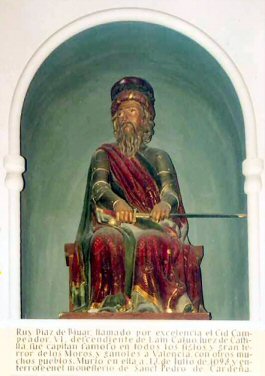by Anna Newec

El Cid
is the name by which the Spanish national hero from the time of the Reconquista Rodrigo Diaz de Vivar became known. The name is derived from the Arabic as-sayyid (,,the Lord") or sidi (,,my Lord") and comes from the time when Rodrigo operated as a mercenary leader in the Spanish Levant.
Life and deeds
Rodrigo (short form Ruy) was born around 1043 in the village of Vivar, located 7 km from Burgos, and was the son of a Castilian grandee. Half-orphaned, he grew up in the court of King Ferdinand the Great of Castile and Leon, together with his son Sancho.
After the king's death in 1065 and the division of the kingdom among his three sons, Rodrigo remained in the retinue of Sancho, who became king of Castile as Sancho II and sought dominion over the other two constituent kingdoms of Galicia and León. Rodrigo held the office of royal standard bearer (Alférez Real or Armiger Regis) and in this capacity achieved his first military successes as a commander of troops. Already in his time at the Castilian court he received the epithet el Campeador or campi doctor, a title derived from the Latin campio (combatant, duelist), which refers to the victorious passing of duels as a fighting representative of a warlord or a party in dispute. In German this epithet is usually translated as "der Kämpfer" (one could also literally say "der Champion").
When the king was assassinated in 1072 during the siege of Zamora and his brother and rival Alfonso VI reunited the kingdoms of León and Castile, Rodrigo, as Alférez, is said to have taken from him the oath of purification demanded by the Castilian estates (Cortes), with which Alfonso affirmed that he had nothing to do with the death of his brother. In any case, Rodrigo remained in the service of the new king and was even given his cousin Jimena Diaz as his wife in 1074. The associated social advancement is shown by the adoption of the surname Diaz, which he used from now on. However, he had to relinquish the office of standard bearer, first to a representative of the Leonese nobility, then to the Castilian knight Garcia Ordóñez, promoted to Count of Nájera, who plays a role in the legend as Rodrigo's courtly adversary.
After various high-handed conquests and interference, not desired by the king, in a regional conflict between Seville and Granada in southern Spain, in the course of which, in a skirmish in 1080, the Cid managed to capture in humiliating fashion his rival Garcia Ordoñez, who was fighting on the other side, he fell from grace in 1081 and was banished by the king. He went to the court of the Moorish prince al-Mu'tamin of Saragossa, whom he defended against Christian rulers, among others, as the leader of a standing force of mercenaries financed essentially from the booty they themselves obtained. In addition to his abilities as a military leader, this new form of organization also contributed to the successes of the "gang", whose leader may be imagined as a kind of "robber baron" or "warlord" in this phase. With his steadily growing band, the Cid built up his own position of power in the Levant.
After the heavy defeat of the Castilians against the army of the Berber Almoravids called into the country by the Moorish princes in the battle of Sagrajas, there was a temporary rapprochement between the Cid and Alfonso VI from 1086. From around this time Rodrigo gradually took over the protective rule of the Moorish principality of Valencia, allied with Castile, which he saved from conquest by the Catalans under Count Berenguer Ramón and from 1089/90 sought to develop into a bulwark against the Moorish Almoravid forces advancing once again. After the prince, who was descended from the Toledan dynasty of the Dhun-Nunids, was assassinated in 1092 in the course of a city revolt and the city was temporarily occupied by Almoravid troops, the Cid retook it in June 1094 and defeated the Almoravid relief army soon after in the Battle of Cuarte. He now ruled Valencia as supreme judge and lord (señor) until his death on July 10, 1099, defending the kingdom against the advancing Almoravids, who, however, conquered it only a few years later.

Death
The death of the Cid is legendary: mortally wounded in an ambush, he made a deathbed promise to his followers to attack the enemy again. In accordance with his wishes, the carefully made-up corpse was tied to the horse in full armor before the battle. His faithful mare Bavieca carried the dead man forward into the fray, sword in hand. Motivated in this way, his men won a brilliant victory over the Berbers, who were frightened by the appearance of the dead man.
Little is known about the actual circumstances of the death. Curiously, however, the death of the Cid falls almost to the day on the date of the bloody conquest of Jerusalem by the Crusaders.
When the city was about to be taken by the Almoravids in 1102, Alfonso VI, who had been called to help, was only able to evacuate the widow and the body of the Cid together with his troops from Valencia and abandoned the city to fire. The goal of stopping the advance of the Berber conquerors in the east of the Pyrenean peninsula had thus failed. A decisive reason was probably the fact that the Cid no longer had any male descendants after his only son Diego had died in the battle of Consuegra near Toledo in 1097.
The Cid was buried in his Castilian homeland in the monastery of San Pedro de Cardeña near Burgos; today the tomb is in the Gothic cathedral of Burgos. His sword Tizona can be seen in the Army Museum in Madrid.